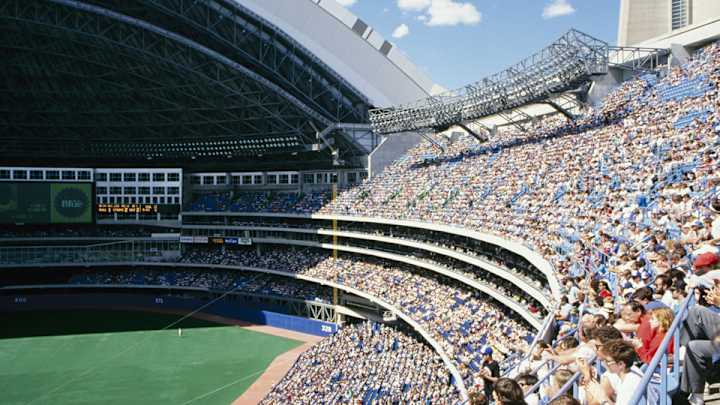Ballpark Quirks: Opening up the sky at Toronto's Rogers Centre

Part innovation and part staunch conservatism, Rogers Centre (formerly known as SkyDome) opened stadium design in an entirely new way.
The first major retractable roof stadium to work — Pittsburgh's early 1960s hockey arena roof stayed closed after a few openings and Montreal’s 1976-opened Olympic Stadium never worked properly either — Rogers Centre not only opened the stadium world to the sky, but it also returned major stadiums downtown, even if the building was cased in multi-purpose design alignments popular in the 1980s.
Ballpark Quirks: Dodgers build a hilly home in Los Angeles' Chavez Ravine
But forget the bland concrete for now. Angus Robbie was 25 in 1989 when the stadium opened. The son of Rogers Centre architect Rob Robbie, Angus said the literal opening of the stadium and the roof showed a monumental shift in sports venue design.
The concept of a retractable roof came from public officials, an idea Rob was happy to support. His design beat out three others, including one that resembled the failed Philadelphia fan style, to win the job.
"He wanted something foolproof," Angus said. "He and partner Mike Allen, the structural engineer, wanted something they knew was going to work." That’s why there's no vertical lift visible in Rogers Centre’s roof, only horizontal movement. "If something goes wrong, you have gravity working against you (with vertical lift)."
The roof used standard railway technology, the same found in steel mills to move buckets of molten metal. In Toronto, though, it was steel wheels rolling on steel rails moving an 11,000-ton roof consisting of four panels to expose 100 percent of the field and 91 percent of seats. It opens in 20 minutes.
"At the time, it was a very innovative building," Angus said. "There wasn’t anything like it."
JAFFE: Resurgent Yankees remain in AL wild-card hunt
Angus admitted that mixed reviews about the building remain, but blames that on ownership’s requirement of designing a multi-purpose venue. More importantly to him, Rogers Centre proved that retractable roofs could actually work. On top of that, placing a large stadium downtown "changed that paradigm completely" of where stadiums were located.
So, while conventional in design and technology, the end result and location proved innovative. Also innovative was one of the largest change orders, if not the largest change order, in stadium history: A $100 million hotel.
"Initially the hotel was not part of the design at all," Angus said. The hotel structure, housing about 360 rooms, including 70 that look onto the stadium’s playing surface, cantilevers off the back of the stadium. The hotel foundations are the back of Rogers Centre, with the hotel overhanging a railway.
Banged-up Athletics struggling as race for AL West supremacy tightens
"It is quite a wild structure," Angus said.
From an in-stadium hotel in a roughly 50,000-seat downtown stadium to the first working retractable roof in major sports, Rogers Centre opened up a world of possibilities.
Tim Newcomb covers stadiums, design and gear for Sports Illustrated. Follow him on Twitter at @tdnewcomb.

Based in the Pacific Northwest, Tim Newcomb covers stadiums, sneakers, design, training and technology across all sports.